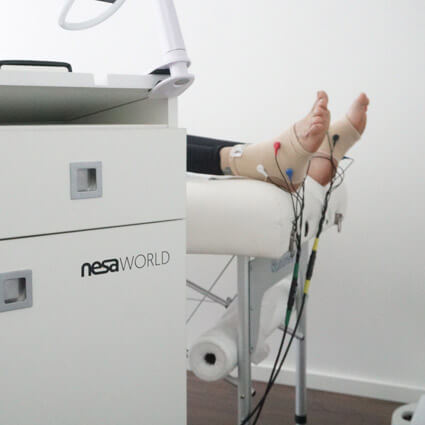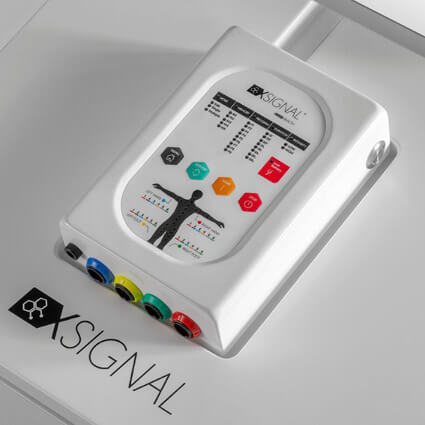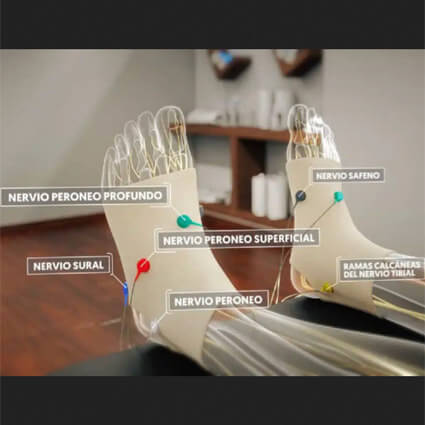Targeted Neurological Relief with Non-Invasive NESA® Therapy
NESA® Therapy gently stimulates nerves to reduce pain and improve muscle function.
How NESA® Therapy Can Help
NESA® therapy’s targeted approach to the nervous system may offer relief for various conditions, including:
- Chronic Conditions: Chronic fatigue/fibromyalgia
- Sleep Disorders: Insomnia, difficulty sleeping
- Mental Wellness: Stress, anxiety
- Pain Management: Chronic pain, musculoskeletal pain
- Urological Issues: Certain bladder conditions
With over 20 years of research in bioelectricity and non-invasive neuromodulation, NESA®‘s technology is a recognised leader in treating autonomic nervous system imbalances, improving the quality of life for numerous patients in rehabilitation, sports medicine, urogynecology, neurology, and mental health.
A Leading Provider of NESA® Therapy in the UK
Chiropractic First is proud to be among the first NESA®-approved clinics in the UK, offering this innovative and non-invasive therapy to our patients in Brighton and Hove.
How NESA® Therapy Works
NESA® therapy gently restores balance to your nervous system using the power of electrotherapy, a method supported by over 150 years of clinical research.
During a relaxing session, a trained therapist places special electrodes on your hands and feet. These electrodes deliver microcurrents, tiny electrical pulses that mimic your body’s natural signals, to regulate and calm your nervous system.
When chronic stress, anxiety, or overstimulation disrupt this balance, it can manifest in various health issues.
NESA® therapy helps your body shift from a state of high alert to a more relaxed and restorative mode, promoting improved sleep, increased energy, and enhanced overall wellbeing.




![]()
Book Your NESA® Therapy Sessions Today!
NESA® Therapy is in high demand because it delivers results. We recommend booking your sessions early to ensure you can experience these benefits. Our popular 10-session package (two sessions per week for four to five weeks) offers the most effective approach to tackling chronic issues and restoring nervous system balance. Many clients choose this option as it provides the best results in a consistent, manageable way.
NESA® Therapy Packages
Single Session: £60 (45 minutes)
10-Session Package: £550
See what celebrities and professional athletes are saying about NESA® therapy.
Frequently Asked Questions
How often are the sessions scheduled?
How is the continuation of treatment decided after the initial course of sessions?
After you complete your initial course of treatment, we will conduct a thorough reassessment to evaluate your progress. Based on the results of this reassessment and the goals you’ve achieved, we’ll discuss the next steps in your care. This might involve continuing treatment, perhaps at a less frequent interval (e.g., every two weeks or once a month), or exploring other options according to your health.
Is NESA® Non-Invasive Neuromodulation 100% effective for all conditions it treats?
Like any therapy, NESA® isn’t a guaranteed cure for every condition. However, when used appropriately, it can be highly effective. Success depends on several factors, including a thorough assessment and accurate diagnosis, a detailed understanding of your medical history, active participation in the treatment process, and a treatment plan based on sound clinical reasoning. When these factors are in place, we see high success rates with NESA® for conditions like neuropathic pain, sleep issues, stress and anxiety, fatigue, and overactive bladder. For optimal results, we usually recommend a minimum of 10 sessions.
While no therapy works for everyone 100% of the time, research supports the effectiveness of neuromodulation for various conditions. Several studies have explored the benefits of non-invasive neuromodulation, including its impact on brain networks, chronic pain management, headaches, and even gait and balance after a stroke.
Why can’t I use my mobile phone during treatment?
Beyond the technical considerations, we also want to create a relaxing and therapeutic environment for you. Not using electronic devices, including mobile phones, allows you to fully focus on your treatment and promotes a calmer, more beneficial experience. We encourage you to use this time to engage in other relaxing activities, like reading.
Why do I need to remove as much metal as possible during treatment?
NESA® technology offers a potential approach by using neuromodulation to target the ANS. It aims to restore balance to the ANS, potentially reducing pain signals and promoting healing. This approach focuses on rebalancing nerve activity, which may be beneficial for both corticalized and neuropathic pain, as well as the specific pain experiences associated with fibromyalgia and chronic fatigue.
Studies, such as the one by Arslan and Çevik (2022), highlight the role of the sympathetic nervous system in chronic pain, suggesting that its overactivity can worsen pain. Therefore, modulating this system, as NESA® aims to do, may be important for effective pain management for various chronic pain conditions, including fibromyalgia and chronic fatigue. NESA® represents a promising approach to chronic pain by targeting underlying neural imbalances.
What research supports the use of NESA® for bladder conditions?
Overactive bladder (OAB) affects millions of people worldwide and is characterised by urinary urgency, frequency, and incontinence. These symptoms often stem from dysfunctions within the autonomic nervous system, which plays a crucial role in bladder control.
NESA® medical technology uses neuromodulation to target and regulate the autonomic nervous system, aiming to improve bladder function. Studies, including research by Contreras et al. (2023), have shown that NESA® can significantly reduce urinary incontinence, particularly in individuals with multiple sclerosis. Further research, such as the studies by Smith et al. (2023) and Conde et al. (2023), reinforces the connection between autonomic nervous system dysfunction and OAB, and suggests that NESA® may be an effective treatment approach for this condition.
What research supports the use of NESA® for facial pain or trigeminal neuralgia?
TN can be caused by various factors, including blood vessel compression of the nerve, multiple sclerosis, tumours (in rare cases), and age-related changes. Other causes of facial pain can include temporomandibular joint (TMJ) disorders, sinusitis, dental issues, post-herpetic neuralgia, and cluster headaches.
While treatments for facial pain vary depending on the cause, ranging from medications and nerve blocks to surgery for TN, and addressing underlying issues like dental problems or sinus infections for other facial pain, neuromodulation therapies like NESA® may offer relief for chronic facial pain by affecting nerve activity. While specific research on NESA® for trigeminal neuralgia is ongoing, the general principles of neuromodulation suggest its potential to modulate nerve activity and potentially lessen pain signals in these conditions. Further research is needed to fully establish NESA®’s efficacy for different types of facial pain.
What research supports the use of NESA® for jaw pain or tension?
Jaw pain and tension, often related to teeth grinding (bruxism), can be linked to an overactive sympathetic nervous system. Chronic stress and anxiety can keep the body in a heightened state, contributing to jaw muscle tension and involuntary grinding.
NESA® therapy aims to address these issues by using low-frequency microcurrents to rebalance the nervous system. By promoting a calmer, more relaxed state, NESA® may help reduce jaw pain, improve sleep, and alleviate bruxism symptoms.
While specific research on NESA® for bruxism is still being conducted, the therapy’s focus on nervous system regulation suggests its potential to address the underlying causes of jaw tension related to stress.
What research supports the use of NESA® for anxiety and burnout conditions?
Anxiety and stress are widespread concerns globally. Factors like social environment, poor diet, and lack of sleep can contribute to these conditions, leading to elevated cortisol levels and changes in brain wave patterns, both indicators of stress. The World Health Organization (WHO) reports that a large percentage of individuals experience stress, with a smaller but still significant portion suffering from chronic anxiety. Events like the COVID-19 pandemic have further highlighted the prevalence of anxiety and stress (Salari et al., 2020).
NESA® technology offers a potential approach to managing stress and anxiety through neuromodulation. It aims to balance the nervous system, which may help reduce stress markers such as high cortisol levels and irregular brain wave activity. Tracking cortisol levels and heart rate variability can provide objective measures of progress and show improvements in stress and anxiety.
While dedicated research on NESA® for anxiety and burnout is ongoing, the therapy’s focus on nervous system regulation suggests its potential to positively affect these conditions.
